

How brands are using facial recognition to transform marketing. This post comes via Parham Aarabi, the CEO of ModiFace.
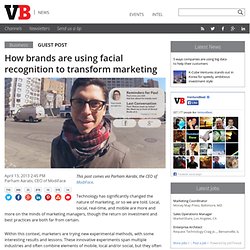
Technology has significantly changed the nature of marketing, or so we are told. Local, social, real-time, and mobile are more and more on the minds of marketing managers, though the return on investment and best practices are both far from certain. Within this context, marketers are trying new experimental methods, with some interesting results and lessons. These innovative experiments span multiple industries and often combine elements of mobile, local and/or social, but they often share an element of personalization (i.e., making the marketing message about the individual, their friends, their photos, their location, etc.). Underhand Tactics: Neuromarketing - Java Films. 4 Ways You Can Innovate Better, According to Neuroscience. Can Neuroscience Explain Innovation? What's Better for Business: Logic or Emotion? Answers From Neuroscience.
Colin Camerer: Neuroscience, game theory, monkeys. Report: 70% of Consumers Trust Brand Recommendations From Friends. Seventy percent of consumers trust brand recommendations from friends, but only 10% trust advertising, according to a new report from Forrester Research.
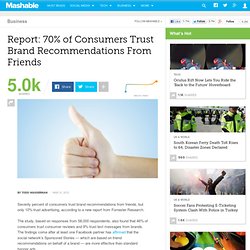
The study, based on responses from 58,000 respondents, also found that 46% of consumers trust consumer reviews and 9% trust text messages from brands. The findings come after at least one Facebook partner has affirmed that the social network's Sponsored Stories — which are based on friend recommendations on behalf of a brand — are more effective than standard banner ads. Forrester's report advocates branded content, which analyst Tracy Stokes writes "has the ability to create brand differentiating by bridging the gap between TV's emotive power and digital media's efficient reach. " Stokes views branded content as a "pull" model vs. advertising's traditional "push" approach. Forrester defines branded content as: Content that is developed or curated by a brand to provide added consumer value such as entertainment or education.
EBSCOhost: Mind-reading marketers. Video: Forbrugernes hjernevindinger bliver kortlagt på Institut for Afsætningsøkonomi. Skiltet ved DNRG SenseLab er ganske beskedent: et stykke papir i et plastikchartek, men inde bag døren, står adjunkt Thomas Zöega Ramsøy i spidsen for forskning, der i CBS-sammenhæng er ganske revolutionær og som vækker opmærksomhed i den store verden.
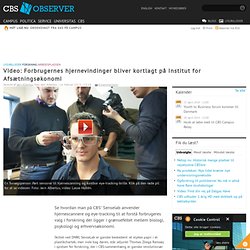
CBS’ hjerneforsker Thomas Zöega Ramsøy er oprindelig uddannet neuropsykolog oven i købet med autorisation, han har også en erhvervsøkonomisk uddannelse fra Norges Handelshøjskole. Copenhagen Business School, CBS - Academia.edu. Type to search for People, Research Interests and Universities Searching...

Change Photo. Neuromarketing's Social Media "Buy Button": How It Works. Neuromarketing's Social Media "Buy Button": How It Works Are neuromarketing and social media connected?
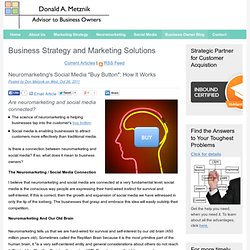
The science of neuromarketing is helping businesses tap into the customer's buy button.Social media is enabling businesses to attract customers more effectively than traditional media. Behavioral economics. The End of Rational Economics. In 2008, a massive earthquake reduced the financial world to rubble.

Standing in the smoke and ash, Alan Greenspan, the former chairman of the U.S. Federal Reserve once hailed as “the greatest banker who ever lived,” confessed to Congress that he was “shocked” that the markets did not operate according to his lifelong expectations. Neurobranding. Branding and the Brain. What does your preference for your favorite cola have to do with Pavlov’s dogs?

New studies described in New Scientist used fMRI (functional Magnetic Resonance Imaging) scans of the brain show that our brand preferences may be stored in much the same way as Pavlov’s famous canines learned to salivate when they heard the food bell. The tests used visual images and a juice reward to evaluate brain activity in humans. The subjects quickly learned to associate a particular image with a more pleasant juice flavor, and began (like Pavlov’s dogs) to respond purely to the visual cue. The article suggests that brand preferences are formed when an individual has a good experience with a brand. Meanwhile, the Sacrificial Rabbit blog is concerned about the whole idea of brain science marketing. What Neuromarketing Can Teach Social Media. I recently learned more about the field of neuromarketing at a lecture by neuromarketing scientist, sales presentation guru and passionate speaker Christophe Morin, founder of Sales Brain.

Bigger Brain = Social Media Success. Hiring a social media manager or a salesperson?
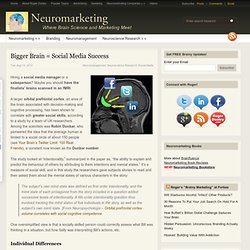
Maybe you should have the finalists’ brains scanned in an fMRI. A larger orbital prefrontal cortex, an area of the brain associated with decision-making and cognitive processing, has been shown to correlate with greater social skills, according to a study by a team of UK researchers. Among the scientists was Robin Dunbar, who pioneered the idea that the average human is limited to a social circle of about 150 people (see Your Brain’s Twitter Limit: 150 Real Friends), a constant now known as the Dunbar number. The study looked at “intentionality,” summarized in the paper as, “the ability to explain and predict the behaviour of others by attributing to them intentions and mental states.” It’s a measure of social skill, and in this study the researchers gave subjects stories to read and then asked them about the mental states of various characters in the story: Individual Differences. Social Media.